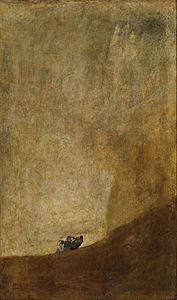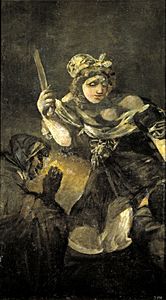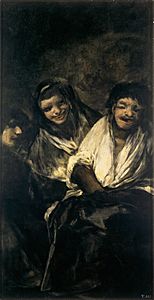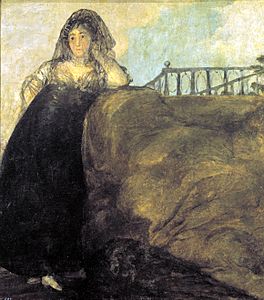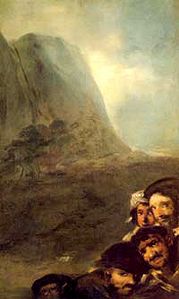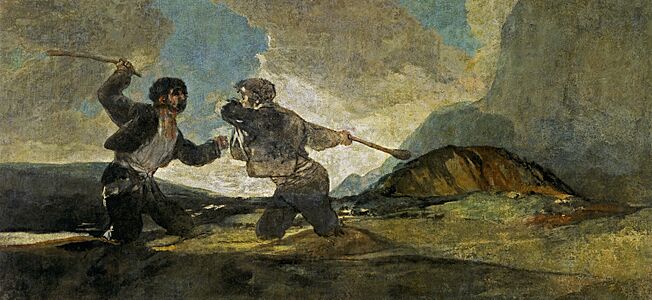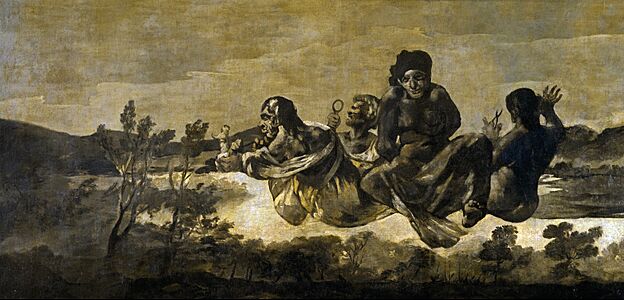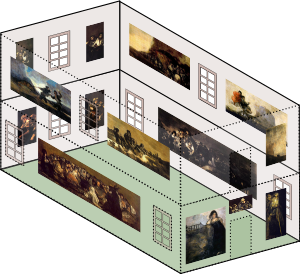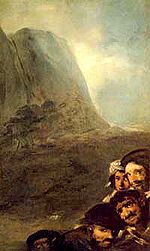Black Paintings facts for kids
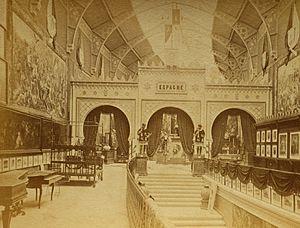
The Black Paintings (in Spanish: Pinturas negras) are a famous group of 14 paintings by the Spanish artist Francisco Goya. He created them later in his life, probably between 1819 and 1823. These paintings show strong, sometimes scary, themes. They reflect Goya's worries about his health and his sad feelings about people.
In 1819, when Goya was 72, he moved to a two-story house outside Madrid. It was called Quinta del Sordo, which means Deaf Man's Villa. The house got its name from its previous owner, who was deaf. Goya himself was almost deaf at this time. He had become deaf after an illness when he was 46.
Goya originally painted these works directly onto the walls of his house. Years later, an owner named Baron Frédéric Émile d'Erlanger carefully removed them from the walls and put them onto canvas. Today, you can see all these paintings in the Museo del Prado in Madrid, Spain.
After the Napoleonic Wars and many changes in the Spanish government, Goya felt very bitter about the world. He had seen a lot of panic, fear, and chaos firsthand. He also survived two serious illnesses, which made him very anxious about getting sick again. These experiences likely led him to create the Black Paintings.
Goya used oil paints and worked right on the walls of his dining and sitting rooms. He made paintings with dark and unsettling themes. He did not create these paintings for anyone else to buy or display. It is believed that Goya never planned for them to be shown to the public. They were very personal artworks, meant only for his home.
Goya never gave titles to these paintings. If he did, he never told anyone. Most of the names we use today were given by art experts later on. Goya's friend, Antonio Brugada, first listed them in 1828. There are 14 paintings in the series. Some of the most well-known are: Saturn Devouring His Son, The Dog, and Witches' Sabbath.
Contents
Famous Black Paintings
-
(El perro), The Dog, 1819–1823
-
(Dos viejos/Un viejo y un fraile), Two Old Men, 1819–1823
-
(Hombres leyendo), Men Reading, 1819–1823
-
(Judith y Holofernes), Judith and Holofernes, 1819–1823
-
(Una manola/La Leocadia), La Leocadia, 1819–1823
-
(Duelo a garrotazos), Fight with Cudgels, 1819–1823
-
(Dos viejos comiendo sopa), Two Old Ones Eating Soup, 1819–1823
-
(Peregrinación a la fuente de San Isidro/Procesión del Santo Oficio), Pilgrimage to the Fountain of San Isidro, 1819–1823
-
(El Gran Cabrón/Aquelarre), Witches' Sabbath, 1819–1823
-
(La romería de San Isidro), A Pilgrimage to San Isidro, 1819–1823
-
(Vision fantástica/Asmodea), Asmodea, 1819–1823
-
(Átropos/Las Parcas), Atropos, 1819–1823
History of the Paintings
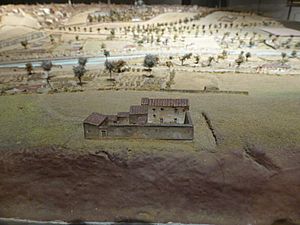
Goya bought the Quinta del Sordo house in February 1819. It was located by the River Manzanares near Madrid. Some people think he bought the house to get away from public attention. He lived there with his companion and maid, Leocadia Weiss.
No one knows exactly when Goya started painting the Black Paintings. He might have begun between February and November 1819. This was when he became very ill, as shown in his painting Self-portrait with Dr Arrieta (1820). We do know that Goya painted these murals over older, lighter scenes. He even used parts of the old landscapes in some of his new murals, like Fight with Cudgels.
It's thought that Goya's illness and the political problems in Spain at the time led him to paint over these earlier works. The Black Paintings were likely created around 1820. They were probably finished by 1823. That year, Goya left the house to his grandson Mariano before moving to Bordeaux. He might have left because he feared trouble after the fall of a republican leader, Rafael Riego. Mariano later gave the house to his father, Javier de Goya, in 1830.
The process of moving the murals from the walls to canvas started in 1874. The walls of the house had wallpaper, and Goya had painted on top of it. This wallpaper layer was carefully removed and then attached to canvas. This difficult work was done by Salvador Martínez Cubells. He was asked to do it by Baron Émile d’Erlanger, a French banker. The Baron wanted to show the paintings at the Paris World's Fair in 1878. However, in 1881, the Baron gave the paintings to the Spanish government. They are now on display at the Museo del Prado.
Where the Paintings Were
When Antonio Brugada listed the paintings, he mentioned seven murals on the ground floor and eight on the top floor. But only fourteen paintings ended up at the Museo del Prado. Another writer, Charles Yriarte, also described an extra painting. He said that when he visited the house in 1867, this painting had already been taken off the wall. Many experts believe this missing painting is Heads in a landscape.
There's also some debate about where Two Old Ones Eating Soup was located. It's not clear if it was on the upper or lower floor. But generally, we know how the murals were arranged in the Quinta del Sordo.
The ground floor was a rectangular room. On the two longer walls, there were two large murals. A Pilgrimage to San Isidro was on the right, and Witches' Sabbath was on the left. On the back wall, Judith and Holofernes was on the right, and Saturn Devouring His Son was on the left. La Leocadia was next to a door, and Two Old Men was opposite Judith.
The first floor was the same size. On the right-hand wall, Asmodea was near the entrance, and Procession of the Holy Office was further along. On the left wall were Atropos and Fight with Cudgels. On the back wall, Man Mocked by Two Women was on the right, and Men Reading was on the left. The Dog was to the right of a door, and Heads in a landscape was to the left.
Two Old Ones Eating Soup was likely above one of the doors. Some experts think it was above a ground floor door.
We know about the original look and placement of the murals from old writings. We also have photographs taken by Jean Laurent in 1874. These photos were ordered by Baron d'Erlanger when the paintings were being moved. Laurent's pictures accurately show how the murals looked before they were taken off the walls. Art historians had been worried for years that the house would be torn down, and the paintings lost.
Laurent's photographs show that the murals had painted borders. The walls were covered in wallpaper, which was common in wealthy homes. The ground floor wallpaper had fruit and leaf designs. The first floor had geometric patterns. The photos also show that a large part of Witches’ Sabbath was missing before it was moved to canvas.
Are They Really Goya's?
Art expert Juan José Junquera has questioned if the Black Paintings are truly by Goya. In 2003, he suggested they might not have been painted during Goya's lifetime. Junquera said that old legal papers describe the Quinta del Sordo as having only one floor. He believed the second floor was added after Goya died. If the upper floor didn't exist when Goya lived there, then the paintings found on that floor couldn't be his work.
Junquera thought that Goya's son, Javier, might have painted them. Then, Javier's son, Mariano, might have pretended they were Goya's to make money. However, another Goya expert, Nigel Glendinning, disagreed with this idea. He published a study defending the paintings' authenticity. He showed links between the Black Paintings and other works by Goya. He also pointed to old documents, like a list of Goya's belongings from 1812, which included these works. Today, the Museo del Prado officially recognizes the Black Paintings as authentic works by Goya.
See also
 In Spanish: Pinturas negras para niños
In Spanish: Pinturas negras para niños
- List of works by Francisco Goya



